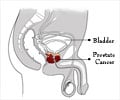A new study, conducted by teams in Stockholm and Boston, looked at the relationship between prostate-specific antigen, or PSA (the chemical currently
A new study, conducted by teams in Stockholm and Boston, looked at the relationship between prostate-specific antigen, or PSA (the chemical currently used as a ‘marker’ for prostate cancer progression), and two other blood proteins.
It was found that men with prostate cancer who could not be detected by the PSA test could potentially be picked up by measuring levels of the two other proteins – called insulin-like growth factor 1 (IGF-1) and insulin-like growth factor binding protein 3 (IGFBP-3). Prostate cancer is the most common cancer in men over 55, but there is no single test that is sufficiently accurate to justify a program of screening all men in this age group.Current guidelines, set by the NH&MRC, advise that only men with symptoms (such as problems with urinating, or blood in the urine) be tested. The first stage of testing includes both a rectal examination and a blood test for PSA levels. A diagnosis of prostate cancer is then confirmed or excluded using a biopsy.
That same group of men, however, had other potential cancer indicators: their levels of the protein IGF-1 were higher than those of a similar group of men who were cancer-free, and their levels of IGFBP-3 were lower. Furthermore, while levels of IGF-1 were high for all men with prostate cancer, low levels of IGFBP-3 were found only in those with low PSA levels.
Low levels of IGFBP-3 and high levels of IGF-1, the researchers suggest, might therefore be used to design a more sensitive test for prostate cancer: one that would identify cases that would not be detected through a PSA test alone. Low levels of IGFBP-3 might also identify men at high risk of developing prostate cancer in the future.

![Prostate Specific Antigen [PSA] Prostate Specific Antigen [PSA]](https://www.medindia.net/images/common/patientinfo/120_100/prostate-specific-antigen.jpg)






